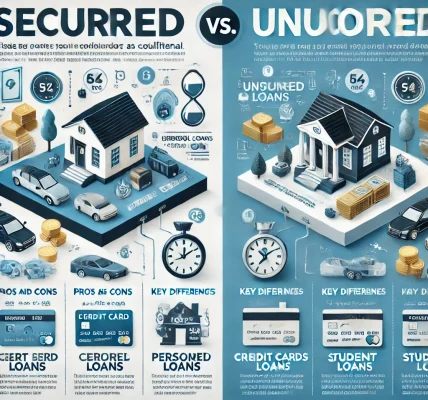Loans play a crucial role in helping individuals and businesses achieve financial goals, whether it’s buying a house, expanding a business, or handling emergencies. However, different types of loan policies govern the lending process, influencing eligibility, interest rates, repayment terms, and conditions. Understanding these policies is essential for making informed borrowing decisions. In this guide, we will explore various types of loan policies and how they impact borrowers.
1. Secured Loans vs. Unsecured Loans
Secured Loans
A secured loan requires the borrower to pledge an asset (collateral) as security for the loan. If the borrower fails to repay, the lender has the right to seize the collateral to recover the outstanding amount.
Examples of Secured Loans:
- Home Loans (Mortgages) – The house serves as collateral.
- Auto Loans – The vehicle is pledged as security.
- Gold Loans – Borrowers use gold assets as collateral.
- Loan Against Fixed Deposits – Banks offer loans against fixed deposit accounts.
Pros:
- Lower interest rates due to reduced risk.
- Higher loan amounts compared to unsecured loans.
- Longer repayment tenure options.
Cons:
- Risk of losing the asset if payments are not made.
- Requires asset valuation and additional paperwork.
Unsecured Loans
Unsecured loans do not require collateral, making them riskier for lenders. Instead, approval is based on factors such as credit score, income, and repayment history.
Examples of Unsecured Loans:
- Personal Loans – Used for various purposes like weddings, travel, or medical expenses.
- Credit Cards – Revolving credit with no specific collateral.
- Student Loans – Education loans without the need for collateral (in some cases).
- Business Loans (Without Collateral) – Given to businesses based on financial stability.
Pros:
- No risk of losing an asset.
- Faster approval process with minimal paperwork.
Cons:
- Higher interest rates due to increased risk.
- Lower loan amounts compared to secured loans.
2. Fixed-Rate vs. Floating-Rate Loans
Fixed-Rate Loans
In fixed-rate loans, the interest rate remains constant throughout the loan tenure. Borrowers pay a fixed EMI (Equated Monthly Installment), ensuring predictable repayment.
Pros:
- Stability in loan repayment.
- Protection from market fluctuations.
Cons:
- Fixed rates may be higher than floating rates initially.
- Less flexibility if market rates decline.
Floating-Rate Loans
Floating-rate loans have variable interest rates that change based on market conditions or benchmark lending rates.
Pros:
- Lower interest rates during economic downturns.
- Possibility of lower overall loan costs.
Cons:
- Uncertainty in EMI payments.
- Higher repayment burden if interest rates rise.
3. Short-Term vs. Long-Term Loans
Short-Term Loans
These loans have shorter repayment periods, usually less than 5 years.
Examples:
- Payday loans
- Small business loans
- Personal emergency loans
Pros:
- Faster approval process.
- Lower total interest paid due to shorter tenure.
Cons:
- Higher EMIs.
- May have stricter repayment conditions.
Long-Term Loans
Long-term loans have extended repayment tenures, typically ranging from 5 to 30 years.
Examples:
- Home loans
- Education loans
- Business expansion loans
Pros:
- Lower monthly EMIs.
- Allows larger loan amounts for big expenses.
Cons:
- Higher total interest paid over time.
- Longer financial commitment.
4. Government-Supported Loans vs. Private Loans
Government-Supported Loans
Governments often provide subsidized loans for specific purposes, such as homeownership, education, or business development.
Examples:
- FHA Loans (Home Loans with Low Down Payments)
- Student Loans (Government-backed Education Loans)
- Small Business Loans (Low-Interest Loans for Entrepreneurs)
Pros:
- Lower interest rates.
- Flexible repayment options.
- Often available to individuals with low credit scores.
Cons:
- Strict eligibility criteria.
- Longer processing times.
Private Loans
Private lenders, including banks and non-banking financial institutions (NBFCs), provide loans based on their own risk assessment models.
Pros:
- Faster approval and disbursement.
- More flexible loan amounts and terms.
Cons:
- Higher interest rates compared to government loans.
- Stricter credit score requirements.
5. Revolving Credit vs. Term Loans
Revolving Credit
Revolving credit allows borrowers to withdraw, repay, and borrow again up to a set credit limit.
Examples:
- Credit Cards
- Lines of Credit (Business & Personal)
Pros:
- Flexible usage.
- No fixed repayment schedule.
Cons:
- High interest rates.
- Easy to fall into debt if not managed properly.
Term Loans
Term loans have fixed repayment schedules, where borrowers receive a lump sum and repay it over a specific period.
Examples:
- Car Loans
- Personal Loans
- Home Loans
Pros:
- Predictable repayment structure.
- Often lower interest rates than revolving credit.
Cons:
- Less flexibility in borrowing additional funds.
- Fixed repayment schedules must be followed.
Conclusion
Understanding the different types of loan policies helps borrowers make informed financial decisions. Whether you need a secured or unsecured loan, fixed or floating interest rates, or government-backed support, knowing these distinctions can guide you toward the right loan for your needs. Before applying, always compare loan terms, interest rates, and repayment conditions to choose the best option for your financial situation.




